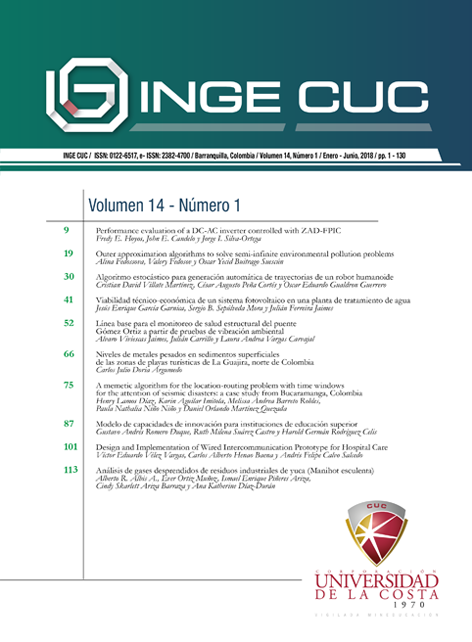Exergetic analysis of a supercritical Brayton cycle with carbon dioxide as working fluid
DOI:
https://doi.org/10.17981/ingecuc.14.1.2018.15Keywords:
Modelling, Energy, Exergy, Reheat, Brayton CycleAbstract
Introduction: Nowadays, the thermodynamic modeling of the power cycles is conceived as an appropriate device which allows analyzing and determining the adaptability of several cycles as well the implementation and combination of a number of components whose characteristics and performing work appropriately on the generation of energy, beside of this, the relevant use of environmentally friendly technologies was taking into account as a relevant factor.
Objective: This research work intends to determine the impact of the performance parameters from the supercritical Brayton cycle related to its energetic and exergetic performance as the variation of the temperature of the cycle as well alternative working conditions are executed by using the reheater and heater systems.
Methodology: This research project used a thermodynamic model to carry out the energy and exergy analysis from four configurations of the supercritical Brayton cycle along carbon dioxide as a working fluid through several levels of temperature, also a maximum pressure of 25 MPa was ratified.
Results: The obtained results have shown the developed and assessed model allowed to demonstrate the configurations through reheat; as for energy there exist a consistent lack of it with regards to the use of the mentioned systems as these have been not configured. In addition, the temperature related to the inlet of the turbine and the pressure ratios have a relevant influence on these lacks by obtaining its minimum value at temperatures between 800-850 ° C.
Conclusions: It can be said that the total lack of exergy is minor as the configurations from the reheater system as it is applied, in other words, it is estimated that through the use of the mentioned system the percentage of reduction aims to three percent as the temperatures increase for the whole configurations.
Downloads
References
[2] G. Amador, J. Duarte, J. García, A. Rincón, A. Fontalvo, A. Bula y R. Padilla, “Maximun power from fluid flow by applying the first and second laws of thermodynamics”, Journal of Energy Resources Technology, ASME, vol. 139, no. 3, 2016. http://dx.doi.org/10.1115/1.4035021
[3] H. Chen, “The conversion of low-grade heat into power using supercritical Rankine cycles,” tesis de maestría, University of South Florida, 2010.
[4] A. I. Kalina, “Combined cycle and waste heat recovery power systems based on a novel thermodynamic energy cycle utilizing low-temperature heat for power generation”, American Society of Mechanical Engineers, Turbo Expo: Power for Land, Sea, and Air, at the Joint Power Generation Conference: GT papers, 1983. https://doi.org/10.1115/83-JPGC-GT-3
[5] Y. D. Goswami, “Solar thermal power technology: present status and ideas for the future”, Energy sources, vol. 20, no. 2, pp. 137-145, 1998. https://doi.org/10.1080/00908319808970052
[6] A. Fontalvo, H. Pinzón, J. Duarte, A. Bula, A. González, “Exergy analysis of a combined power and cooling cycle”, Applied Thermal Engineering, vol. 60, no. 1, pp. 164-171, 2013. https://doi.org/10.1016/j.applthermaleng.2013.06.034
[7] E. D. Rogdakis y K. A. Antonopoulos, “A high efficiency NH3/H2O absorption power cycle”, Heat Recovery Systems and CHP, vol. 11, no. 4, pp. 263-275, 1991. https://doi.org/10.1016/0890-4332(91)90072-C
[8] C. S. Turchi, Z. Ma, T. W. Neises y M. J. Wagner, “Thermodynamic study of advanced supercritical carbon dioxide power cycles for concentrating solar power systems”, Journal of Solar Energy Engineering, vol. 135, no. 4, 2013. https://doi.org/10.1115/1.4024030
[9] R. Padilla, Y. Chen, R. Benito y W. Stein, “Exergetic analysis of supercritical CO2 Brayton cycles integrated with solar central receivers”, Applied Energy, vol. 148, pp. 348- 365, 2015. https://doi.org/10.1016/j.apenergy.2015.03.090
[10] R. Padilla, A. Ramos, G. Demirkaya, S. Besarati, D. Goswami, M. Rahman y E. Stefenakos, “Performance analysis of a Rankine cycle integrated with the Goswami combined power and cooling cycle”, Journal of Energy Resources Technology, vol. 143, no. 3, 2012.
[11] Tzu-Chen Hung, “Waste heat recovery of organic Rankine cycle using dry fluids”, Energy Conversion and Management, vol. 42, no. 5, pp. 539-553, 2001. https://doi.org/10.1016/S0196-8904(00)00081-9
[12] Y. Chen, P. Lundqvist, A. Johansson y P. Platell, “A comparative study of the carbon dioxide transcritical power cycle compared with an organic Rankine cycle with R123 as working fluid in waste heat recovery”, Applied Thermal Engineering, vol. 26, no. 17, pp. 2142-2147, 2006. https://doi.org/10.1016/j.applthermaleng.2006.04.009
[13] V. Dostal, M. J. Driscoll y P. Hejzlar, “A supercritical carbon dioxide cycle for next generation nuclear reactors”, Dept. of Nuclear Engineering, Massachusetts Institute of Technology, 2004.
[14] M. D. V. Kulhánek, “Thermodynamic analysis and comparison of supercritical carbon dioxide cycles”, de Proceedings of Supercritical CO2 Power Cycle Symposium, 2011.
[15] A. Moisseytsev y J. J. Sienicki, “Investigation of alternative layouts for the supercritical carbon dioxide Brayton cycle for a sodium-cooled fast reactor”, Nuclear Engineering and Design, vol. 239, no. 7, pp. 1362-1371, 2009. https://doi.org/10.1016/j.nucengdes.2009.03.017
[16] J. Sarkar, “Second law analysis of supercritical CO2 recompression Brayton cycle”, Energy, vol. 34, no. 9, pp. 1172-1178, 2009. https://doi.org/10.1016/j.energy.2009.04.030
[17] A. Moisseytsev y J. Sienicki, “Performance improvement options for the supercritical carbon dioxide Brayton cycle,” [Tech. rep. ANL-GenIV-103] Argonne National Laboratory (ANL), Chicago, 2007. http://www.ipd.anl.gov/anlpubs/2008/07/61951.pdf
[18] E. G. Feher, “The supercritical thermodynamic power cycle”, Energy conversion, vol. 8, no. 2, pp. 85-90, 1968. https://doi.org/10.1016/0013-7480(68)90105-8
[19] M. J. Moran y H. N. Shapiro, Fundamentals of engineering thermodynamics, 5th ed., Hoboken, N. J.: John Wiley and Sons, 2004.
[20] S. P. Kao, J. Gibbs y P. Hejzlar, “Dynamic simulation and control of a supercritical CO2 power conversion system for small light water reactor applications”, Proceedings of supercritical CO2 power cycle symposium, 2009.
[21] H. T. Hoang, M. R. Corcoran y J. W. Wuthrich, “Thermodynamic study of a supercritical CO2 Brayton cycle concept”, Proceedings of supercritical CO2 power cycle symposium, 2009.
[22] W. Seidel, “Model development and annual simulation of the supercritical carbon dioxide Brayton cycle for concentrating solar power applications”, tesis doctoral, University of Wisconsin-Madison, 2011.
[23] Mathworks, Matlab. Computer Program. Massachusetts: MATLAB, 2014.
[24] E. W. Lemmon, M. L. Huber y M. O. McLinden, “NIST standard reference database 23: reference fluid thermodynamic and transport properties-REFPROP”, [Tech. rep.], version 9.1. Standard Reference Data Program, National Institute of Standards and Technology, Gaithersburg, 2013.
[25] S. Mishra, “Some new test functions for global optimization and performance of repulsive particle swarm method”, 2006. Disponible en: SSRN 926132.
[26] S. M. Besarati y D. Y. Goswami, “Analysis of advanced supercritical carbon dioxide power cycles with a bottoming cycle for concentrating solar power applications”, J. Sol. Energy. Eng, vol. 136, no. 1, 010904-1-7, 2014.
[27] R. Viswanathan, K. Coleman y U. Rao, “Materials for ultra-supercritical coal-fired power plant boilers”, International Journal of Pressure Vessels and Piping, vol. 83, no. 11, pp. 778-783, 2006. https://doi.org/10.1016/j.ijpvp.2006.08.006
Downloads
Published
How to Cite
Issue
Section
License
Published papers are the exclusive responsibility of their authors and do not necessary reflect the opinions of the editorial committee.
INGE CUC Journal respects the moral rights of its authors, whom must cede the editorial committee the patrimonial rights of the published material. In turn, the authors inform that the current work is unpublished and has not been previously published.
All articles are licensed under a Creative Commons Attribution-NonCommercial-NoDerivatives 4.0 International License.



 English
English
 Español (España)
Español (España)






















